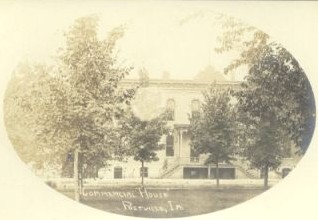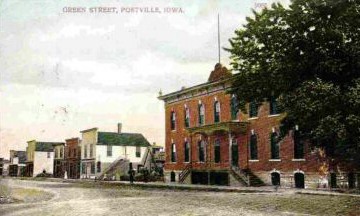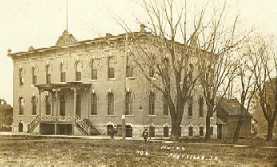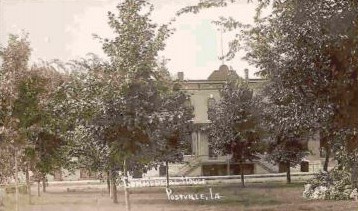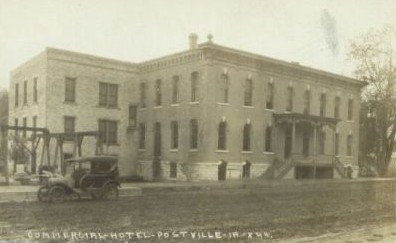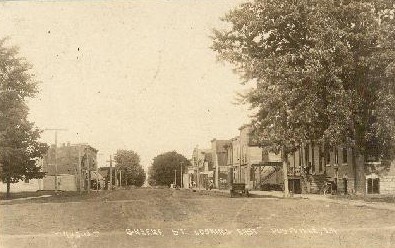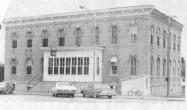THE COMMERCIAL
HOTEL
Last week we promised to "write up" the new
hotel in detail. Not yet being entirely completed, we are
unable to give it as full and complete a showing up as we
would like, but from the following description the public
can gather a very good idea of the structure and its
details.
To begin at the foundation, the building is 50 by 71 feet
on the ground, outside, fronting north on Green street.
The basement is of solid stone, and is about one-half
above ground, giving ample light through a number of half
windows. The basement story is nine feet in the clear,
and divided into three rooms of equal size, 24 X 50 feet
outside. The west or corner room is occupied by Mr.
Humphrey as a billiard hall, and two of the J. M.
Brunswick & Blake billiard tables, latest and best
pattern, are already in position, and a splendid circular
bar is to be added, with chairs and the necessary
furniture, to make it the best and most tasty hall in the
country.
The next room east is to be subdivided into store rooms
for the two side main rooms with a cellar for the house
in the center, and a commodious and convenient wash room
in the rear, with a well and pump in the room, and
connected with the first floor by a stairway. The east
room of the basement is not yet finished, but will be
finished substantially the same as the west room, and
will be for rent for some business purpose. This finishes
the description of the basement. It is reached by steps
from the sidewalk at the east and west corners.
Ascending the steps in front to the first floor and
entering through the right hand entrance, we open into a
commodious hall from which the main stairway passes. The
first room to the right is the sitting room, a pleasant
room 16 X 24, with a bed room opening on the west, and
the family rooms on the south. South of this are the
kitchen pantry, closet &c., all large and
conveniently arranged. To the east of the kitchen is the
dining hall, 24 X 39 feet. Entering by the left hand
front entrance, or through the hall at the foot of the
main stairway, we are in the office, a fine room 24 feet
square, which will be well furnished. Opening from the
office, in the northeast corner of the building, is the
sample room, and it will be a pleasant one too. The
balance of this floor will be occupied by the wash room
which is to be finished in marble in elegant style, and
the baggage room.
Ascending the main stairway to the second floor the
parlor, with bedroom attached, is on the right or in the
northwest section. The balance of this floor is divided
into rooms and suits of rooms, all of them light and airy
and all of them commodious. Exclusive of the parlor there
are 22 rooms on this floor, all of which are to be
tastefully, if not elegantly furnished. A stairway leads
from this story to the roof and long windows open to the
veranda in front. This story, as well as the first story
is 12 feet from floor to ceiling, making the rooms all
high and pleasant. All the windows drop from the top with
weights and raise from the bottom, with a patent fastner.
A stairway also ascends to this story from the rear.
Outwardly the building is of white Clermont brick, laid
around a substantial wood frame sheeted up, commonly
termed "veneered" work. The mason work was done
by Samuel Keiser, and we should say it was a good and
tasty job. The carpenter and joiner work is by Barhans
& Darling, and will compare favorably with the best
work in the country. When the painter and grainer have
gone over it it will present as near a perfect appearance
as we ordinarily find anywhere. We should have said in
the proper place that the roof is of tin, with a pitch of
two feet in fifty.
This, we believe gives a general outline of the
Commercial Hotel, Postville, Iowa, H. S. Humphrey
proprietor, which next week will be open to the public
during the Fair, and perhaps permanently, although the
finishing touches of the grainers and painters will not
then be all on. The bare building, exclusive of furniture
and fixtures of every and any kind, will cost not far
from $10,000, and it is a building of which Postville and
Northern Iowa may well feel proud, as there is no such
building in this section of the State. Long may it stand,
a monument to the energy of the owner and his faith in
the future of Postville. May it be to him a source of
ample profit, as well as a "thing of beauty and a
joy forever."
~Postville Review, September 1, 1875
~*~*~*~
Other news clips about the
Commercial Hotel
September 1875: COM'ERCIAL
HOTEL - Corner Green and Reynolds STS - Postville, Iowa.
H. S. HUMPHREYS. Proprietor
This hotel has just been erected, the rooms are all
large, well lighted and supplied with new furniture
throughout. A good sample room for Commerical travelers,
and good stabling attached. A share of patronage
solicited
September 1875: The large chromometer at the
Commerical Hotel, was procured at Mr. Ferrey's jewelry
store. It is one of the first class clocks, with its
regular hour-dial, and dial to indicate the day of the
week, the month and figures. Orders in his line promptly
filled.
September 1876: H. S. Humphrey has sold the
Commercial Hotel to the Johnson Brothers, and taken two
farms in exchange. The transfer of possession was made
last Monday.
February 1877: Johnson Bros. have leased the
Commercial House billard room to Fred Kappes, formerly of
Monona, but late of Calmar.
March 1879: The Commercial Hotel has changed
hands, Messrs. Willard & Moody retiring and Mr.
Abernethy taking the helm. Mr. Abernethy has had much
experience in catering to the public, and we bespeak for
him a full measure of patronage.
August 1879: Mr. Abernethy has retired
from the Commercial Hotel and Johnson Bros. resume
control. Mr. Johnson, father of the Johnson Bros., of the
Commerical restaurant, is in town. His home is in
Louisville, Ky.
January 1881: The Commercial Hotel owned
and run by H.S. Humphreys is a large well arranged hotel,
and under its present proprietorship is run in splendid
shape. Commerical Billiard Hall is in the basement of the
Commercial House and does a good business.
September 1881: H. S. Humphrey has
leased the Commercial Hotel to J. M. Lisher, of the
Burlington House and the transfer will be made next
Monday.
June 1883: Geo. Lull has purchased the
Commercial Hotel of H.S. Humphreys, the consideration
being $8,000.
December 1885: On Wednesday, Geo. Lull
sold the Commercial Hotel to J.M. Lisher, who has been
running it for several years, and making it the most
popular hotel in Northern Iowa. Consideration not stated,
but it is understood that Mr. Lisher got a good bargain.
January 1886: On Monday evening of last
week a progressive euchre party was held in the
Commercial Hotel parlors, which passed off pleasantly.
May 1888: The social party given at the
Commercial Hotel on Thursday evening of last week by Ed.
CORNELL and Halver LIEN was a success.
March 1921: The Commercial Hotel will
serve the following menu at their Easter dinner, 75 cents
per plate. Please make your reservation by Saturday
night. Cream of Tomato, Celery, Olives, Radishes, Green
Onions, Chicken, Dressing, Baked Ham, Mashed Potatoes,
Gravy, Crreamed Peas, Egg Salad, Parker House Rolls,
Lemon and Cherry Pie, Fruit Sherbert, Cheese, Salted
Nuts, Tea, Coffee, Milk.
January 1930: Landlord Reincke has been
adding to the nice appearance of the Commercial Hotel
dining room by the laying of linoleum.
~*~*~*~
MANY OWNERS OF HOTEL LOTS
The fire which destroyed the Commercial
Hotel building here Saturday, March 25, has prompted an
attempt to reconstruct a history of the landmark. The
present owners, Richard and Jean Van Wey, furnished the
Herald with the abstract of the property. Information has
also been gathered from old papers and the 1913 Hancock
history of Allamakee County.
The abstract of title to the Commercial Hotel building
lots proved interesting. The section of land on which
Postville stands was first purchased by Zeruiah Post from
the United States in 1851. She was the wife of Joel Post
for whom Postville is named.
In 1864 Zeruiah Haywood (formerly Zeruiah Post) sold the
land in Postville to John Lawler, who platted the
original part of Postville in that year. This is the year
that the railroad reached Postville. No record of a date
or deed were recorded, but apparently Lawler then sold
the west two lots to Waren Van Hooser and wife, who in
turn sold them to Thomas Osterander on May 6, 1866.
On March 16, 1867 William Collins purchased the two lots
and added another to the east which was purchased from
John Lawler. This must have been a speculation buy by
Collins because he sold to John and Kate Kelly. One would
suspect this was when the building was built, but no
definite proof is available.
The Kellys also obtained the lot on the east side of the
property from John T. Stoneman in August 1869. When John
Kelly and his wife died their estate was left to her
father, John Head, Sr., who gave it to the New Melleray
Abbey near Dubuque. For some reason the east lot was then
sold to J.E. Hughes, who in turn gave it to his wife,
Amanda. This single lot was then owned by the Hughes,
despite mortgaging it several times, until 1898 when it
was sold to A.E. Cornell, who joined it with the original
three lots.
An interesting sidelight to the Kelly ownership was that
his will provided for the sale of two other lots he owned
in Postville and the use of these funds to purchase a
marble monument for he and his wife. They both died in
1874 according to probate notices. Perhaps this could
still be found in the Postville cemetery.
In 1871 John Kelly and his wife sold the lots to J.A. Roe
and his wife C.C., but the Kelly's kept a mortgage, which
ended up with the Abbey at New Melleray. Roe and his wife
kept the property only a year and sold it to H.S.
Humphreys and his wife in January of 1875. September 8
1876 Matilda Johnson bought the building from Humphreys,
but sold it back in January of 1880, to Humphreys.
A copy of the Postville Review of December 30,
1882, lists the proprietor of the Commercial Hotel as
James M. Lisher who also operated a livery stable in
connection with the hotel. Humphreys sold the hotel to
George Lull in 1883, and Lull in turn sold it to James M.
and Mary A. Lisher on January 2, 1886. The Lishers then
operated the hotel until Sept. 19, 1891, when they sold
it to A.E. and Carrie B. Cornell.
It was Cornell who then brought the four lots back
together again. One might suspect that this was when the
addition was made to the southeast corner of the
building. Cornell had a $4,000 mortgage on the building
at that time. The Cornells owned the property until 1912
when they transferred the title to F.W. Meiske and his
wife, Julia, but held a mortgage for over $17,000. The
Meiskes then owned the building and continued to operate
as such until they sold it to Charles F. Reincke on April
15, 1925.
Reincke continued to own the property until 1948, except
for a short period in 1936 when he transferred the title
to his daughter and son and their spouses. They were Fred
and Dorothy Groth and Delmar and Iva Reincke, January 2,
1948 saw the title pass on to Hubert C. and Thelma I.
Luhman and George E. and Pearl B. Cooke.
The Cooke's didn't continue the partnership long as they
sold their half interest to M. Roger and Elen Sherman in
November 1949. The Shermans were in partnership only
about two years before selling out to Luhman in 1952.
Luhman continued the operation until June 2, 1966 when he
sold the business to Ralph J. and Lois N. Schrader.
The Schraders operated it less than a year before selling
it to Robert E. and Los K. Jones, in early 1967. Glen and
Dorothy Schave purchased the property in October of 1973.
They in turn sold it to John E. and Linda Martin in
January of 1976. The Martins sold the building to Richard
and Jean Van Wey in August of 1977.
The Van Weys had started a large renovation project on
the building and completed most of the outside, and were
working on the apartments inside. The furnace which
apparently caused the fire was scheduled to be replaced
this summer.
At one time the hotel had a large dining room and was the
scene of many meetings, receptions, etc. Many early
residents of Postville report eating and attending
parties there. Apparently age and the use of motels led
to the ecline of the use of the building as a hotel. Of
course the dropping of the many passenger trains by the
railroad had led to the original decline.
~Postville Herald, Wednesday,
April 5, 1978
|
![]()
